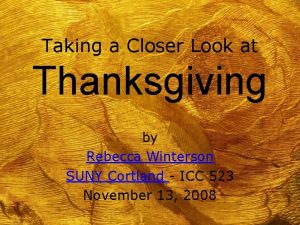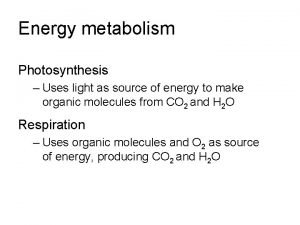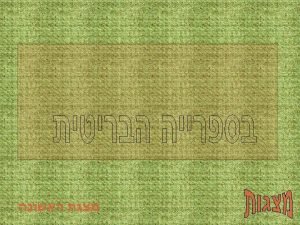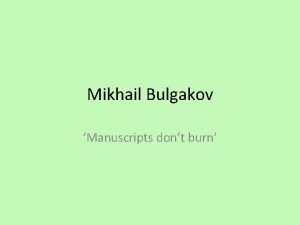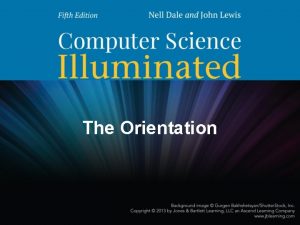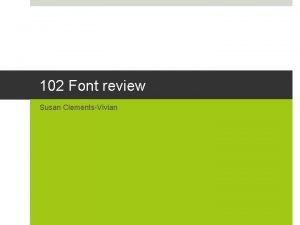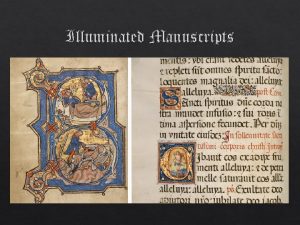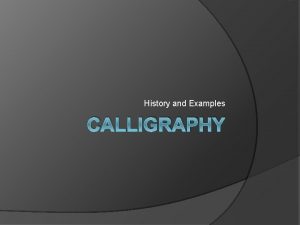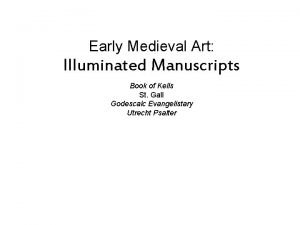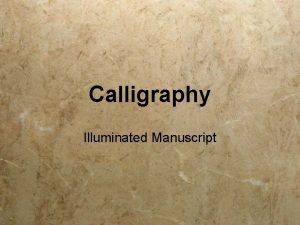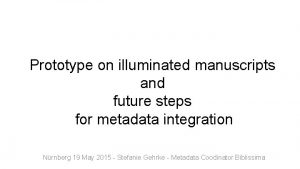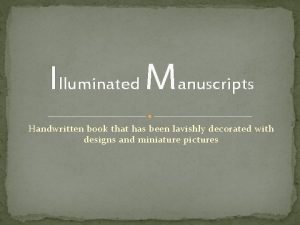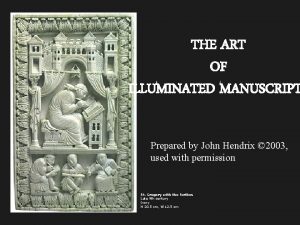Society and Art A Closer Look Illuminated Manuscripts



















- Slides: 19

Society and Art: A Closer Look Illuminated Manuscripts

Medieval Manuscript Vocabulary

Book of Hours � A prayer book intended for use in private or family devotions (prayers) � Usually contain a collection of prayers and devotions dedicated to the Virgin Mary and recited or sung at the � canonical "hours" (eight set times during the day). � Also added other elements such as a calendar, penitential psalms, litanies, suffrages, etc. � Elaborate versions contain a full cycle of miniatures as well as involved marginal decorations. � Books of hours form the most popular and abundant of all surviving medieval manuscripts.

Codex �Another term for all handwritten books (manuscripts) on individual leaves of vellum that can be turned and read in succession. �Became popular after the scroll

Drollery �grotesque. �Animal and human hybrids that inhabit the initials and foliate (leafy) borders of Gothic manuscript leaves.

Historiated Initial �An enlarged initial containing individual figures or groups that interact; they often form narrative scenes that illustrate or refer to the text they introduce.

Illuminated �Decorated with paintings and drawings, usually ornamented with gold, silver, and brilliant colors.

Illuminator �decorator or painter of a vellum codex

Initial �An emphasized letter at the beginning of a text; used in medieval manuscripts to form breaks within a text and to prioritize the components of the text by drawing the attention of the reader �a purely medieval invention and often lavishly decorated. �See also historiated initial

Miniature �A picture, frequently narrative, used as illustration in a manuscript (from Latin minium, a red �pigment used in manuscript painting).

Parchment �The skin of animals (cattle, sheep, or goats) used as manuscript leaves, prepared by soaking and stretching. �Also called vellum, with which it is often used interchangeably.

Medieval Art �Art in Medieval times reflected their societal values �What did they value the most? (Think back to our notes!) �RELIGION �This can even be seen in their manuscripts, or handwritten texts.

Medieval Manuscripts �More medieval books survive from the Middle Ages than any other type of art �Hand-made books are known as manuscripts � Books that contain artistic decoration are known as illuminated manuscripts �Usually religious texts � Mostly Christian � Some Jewish and Muslim texts survive

Codex vs Scroll �Medieval manuscript is a codex � A book of pages bound between two boards � Pages protected by covers, so more survived throughout the ages �Ancient scribes wrote on scrolls that were stored in boxes � Rolls stored in boxes� Fragile-vulnerable to breaking down, so only fragments remain

What’s in the books? �As a reflection of society, most Medieval texts are religious in nature. �The works of philosophers such as Plato and Aristotle �The original manuscripts of these works have not survived. � They are only known today thanks to Medieval scribes who copied them into codices.

A slow process �The printing press did not exist in the Middle Ages � How did they record and spread information, then? �All books were copied BY hand (usually by monks) and most were kept in monastery librairies �Monks traveled to distant monasteries to view and copy books to bring back to their own monasteries. �Many Medieval texts were destroyed in monastery fires, so not all texts survived the Middle Ages

Illustrations �Illustrated manuscripts are known as illuminated manuscripts. �Illustrations were decorative and functional � Marked the beginning of sections � Sometimes told a story (remember- MOST people could not read)

Hey! Check out this Prezi! �http: //prezi. com/bs- rt__z 09 d 2/? utm_campaign=share&utm_medium=cop y&rc=ex 0 share

REVIEW � During the Middles Ages, most people could not read. Only very wealthy or scholarly people owned books, which were handwritten and illustrated. While many books were for religious use, there were also books of music, literature, and legends. � Book manufacture involved a number of steps. Pages were made from parchment, a sturdy material produced from treated and cleaned animal skin. Lines were lightly drawn as guides to keep the writing neat. A quill from a large bird would be used for large text, while a quill from a sparrow might be used for fine writings. Areas were reserved for the illuminations, or illustrations. These might include a border decoration (marginalia), enlargement of the first letter of the text decorated with a scene relating to the topic (historiated initial), or a miniature painting filling either a quarter, half, or a full page.
 Look up and to the left
Look up and to the left A closer look at thanksgiving
A closer look at thanksgiving Look closer see me
Look closer see me Ch 7 a closer look: energy metabolism pathways
Ch 7 a closer look: energy metabolism pathways Chapter 7 a closer look energy metabolism pathways
Chapter 7 a closer look energy metabolism pathways Meiosis prophase 2
Meiosis prophase 2 Original gospel manuscripts
Original gospel manuscripts Jewish manuscripts
Jewish manuscripts Mikhail bulgakov spouse
Mikhail bulgakov spouse Expository sermon manuscripts
Expository sermon manuscripts Jennifer edits manuscripts for a publisher
Jennifer edits manuscripts for a publisher Illuminated object
Illuminated object The difference between luminous and non luminous
The difference between luminous and non luminous Computer science illuminated (doc or html) file
Computer science illuminated (doc or html) file How is the moon illuminated
How is the moon illuminated Area of refuge signage
Area of refuge signage Susan clements-vivian
Susan clements-vivian 0 illuminated moon
0 illuminated moon Computer science illuminated chapter 4 answers
Computer science illuminated chapter 4 answers One day closer quotes
One day closer quotes

